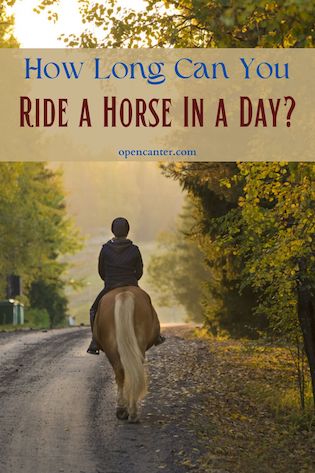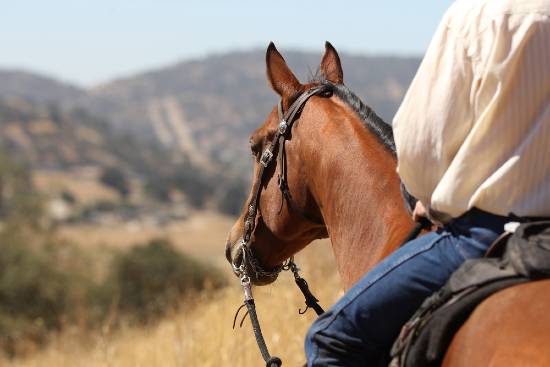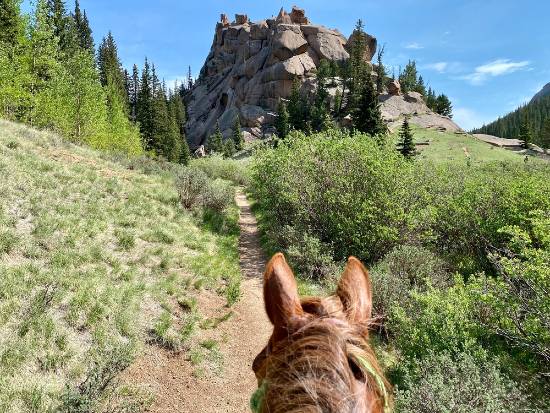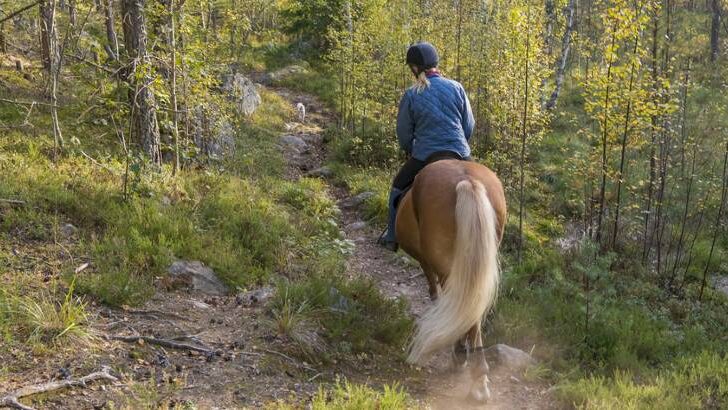Affiliate Disclaimer
As an Amazon Associate I earn from qualifying purchases. It helps me keep the website going. Thank you for your support.
Horses are resilient and tolerant creatures. They will go above and beyond to please their riders, sometimes to the point of hiding pain. However, they still have an energy limit. So, how long can you ride a horse in a day?
The average horse can be ridden 50 miles before needing a break or about 8 hours in a day. Many factors influence how far a horse can travel and for how long, including fitness, the gait they travel in, and endurance.
Knowing this information about horses can help riders adequately plan a horse’s schedule and prevent injury and or burnout. So, read on to learn more about the working abilities of horses.

What is the Greatest Distance You Can Ride a Horse in a Day?
The typical trail-riding horse can cover about 50 miles in a single day without rest. An endurance horse that is trained to go long distances can comfortably go 100 miles in the same time frame. A horse that spends most of its time in arenas and is not required to cover long distances could go somewhere in the range of 20-25 miles max.
If you want to convert that to hours, that is around 8 hours a day if the horse is moving at a walk. They may be able to go for a longer time without stopping if they use a faster gait, but moving faster can cause fatigue. Several factors impact how long you can ride a horse and the speed at which they travel.
Factors That Influence How Long You Can Ride a Horse
Horses may be naturally quick movers because they are flight animals, but this does not mean they are fast all the time. Here are the key characteristics that affect the traveling abilities of a horse.
1) The Horse’s Gait
Gait is the technical term used to describe a horse’s pace and way of going. There are four main gaits: walk, trot, canter (lope), and gallop. Each one has different pacing and speed.
- Walk- the walk is a four-beat gait that can cover 4 miles per hour on average
- Trot- the trot is a two-beat gait that can cover 8 miles per hour on average
- Canter (lope)- the canter or lope in western riding, is a three-beat gait that can cover anywhere from 10-17 miles an hour on average
- Gallop- the gallop is a fast four-beat gait that can cover around 30 miles per hour on average
The overall quality and efficiency of a horse’s gait or pace depend on the horse and the rider’s fitness, weather, and more. You can read more about how far a horse can run in each of the different gaits.
2) Horse Fitness Level and Health
Young horses that have little to no health problems can last for more extended periods than senior horses. Arthritis and other wear and tear that horses accumulate as they age impact their speed and stamina.
For example, a horse with a sustained leg injury will not travel as well as one with clean legs.
However, horses tend to carry on in their job despite fatigue until they absolutely cannot go on. It is up to the rider to keep the horse’s well-being in mind. A tired horse is more prone to injury than a rested one.
Horses are fitter when they are worked regularly with various activities in their routine. Each part of a horse’s schedule should benefit its body in some way. Incorporating both high and low-impact exercises improves fitness while preventing burnout.

3) Terrain or Footing Conditions
Horses cannot maintain the same gait through an entire trip. They will go faster or slower depending on the type and evenness of the ground beneath them. For example, a horse will slow down over hills and bumpy ground to protect its hooves and joints.
Horses will always travel faster over soft and even ground. It is comfortable for them and safe for their hooves to land on.
4) Weather
Poor weather such as rain or snowstorms will slow horses down. They have to work harder to make it the same distance. Horses can also slip on wet ground so it is best to go slow in these conditions.
The optimal outdoor temperature for horses is 70-90 degrees Fahrenheit. Horses can typically travel 10-20 miles in the cold before seeking shelter. Traveling in harsh weather can lead to injury and or illness.
If a horse is ridden for too long in extreme heat, it will become dehydrated. Sweating causes horses to lose electrolytes which makes them dehydrated. Traveling in high winds and cold leads to stiff joints and muscles.
5) Rider Health and Fitness
If the rider is not fit enough for travel, they cannot guide the horse properly. This applies in both schooling and trail riding. The rider also needs the proper skills to guide the horse.
Riders that mind their fitness will have more stamina to travel with their horse for longer periods. The best way to improve fitness for horses and riders is to gradually increase workout session length.
6) Tack
When going on a long trail ride or busy schooling session, you need the right equipment. The right saddle design and fit will allow your horse to move comfortably and take bigger strides.
If a horse loses a shoe, it will affect its ability to move evenly.
As you can see, a horse’s ability to travel for a long time with little injury involves several factors. If one or more of them is lacking, it can negatively impact efficiency.

How Many Lessons Can a Horse Do In a Day?
Horses should not do more than 5 hours of work a day, or 3 hours of work in a row. Some horses can do more than this depending on fitness. However, it is best to keep standard working hours for all horses to prevent exhaustion and illness.
This means anywhere from 3-5 one-hour lessons or 6-10 half-hour lessons.
How Many Show Classes Can a Horse Do In a Day?
Show horses should not have more than four classes in a single day. 10 classes at a show are equivalent to 2 ½ hours of trail riding. Excessive showing will cause fatigue and increase the risk of injury to the horse. A horse cannot perform at its best when it is overworked.
What Happens If You Do Not Let Your Horse Rest?
Horses need time to rest in between work just like humans. If a horse is asked to work for days without a break, their body does not get time to recover. This puts a strain on various tendons, muscles, and ligaments and increases the chance of injury.
The injuries will usually start small and become larger with time. Rest periods allow your horse to adjust to the work they are doing and prevent this. Horses need longer recovery time than humans.
Working muscles in the horse create tiny tears in them, so rest allows the muscle to repair. Neglecting rest can lead to muscle tears. Horses should have active rest days consisting of low-intensity activities such as hand walking along with total rest days. Total rest involves a whole day of pasture time (source).
Working a horse too much can also lead to muscular and skeletal changes, heart problems, and the weakening of the immune system. In extreme cases, overwork causes exhausted horse syndrome.
What Is Exhausted Horse Syndrome?
Exhausted horse syndrome is a life-threatening set of metabolic conditions that occur when a horse is in a state of chronic fatigue. Signs of the syndrome include:
- Dehydration
- Lack of sweating or sweating at inappropriate times
- Depression
- Recumbency
- Abnormal pains
- Laminitis
- Signs of heart failure
- High rectal temperature
Exhausted horse syndrome is typically treated using cooling therapies and taking steps to restore fluid circulation in the body. It is prevented by keeping horses properly hydrated and allowing adequate rest time (source).

Signs of Overwork
Here are some common signs that a horse is overworked and or fatigued:
- Resistance to move into higher gaits, no change in pace
- Constant slowing down
- Unresponsive to aids
- Shortened stride
- Tripping and stumbling
- No lead changes
These signs can also occur if the aids are unclear, but they are still associated with fatigue. Horses will fatigue more quickly if they have been out of work for a long time, they are in their senior years, or they do intense work regularly.
Preventing Overwork
Prevent fatiguing your horse by tracking their fitness and vital signs as they work. Make sure that your horse is properly warmed up so that it can handle the work you ask.
If you need advice, ask your vet for tips to improve fitness. Remember to take plenty of short breaks whether schooling or trail riding. Incorporate a post-workout routine for your horse to help them cool down and reset.
Final Thoughts
How long can you ride a horse in a day? The average horse can trail ride for 50 miles, do 3 to five hours of lessons, or enter 4 classes at a show in a day. These statistics vary according to horse fitness and other variables. Horses need rest to prevent fatigue and muscle breakdown.




